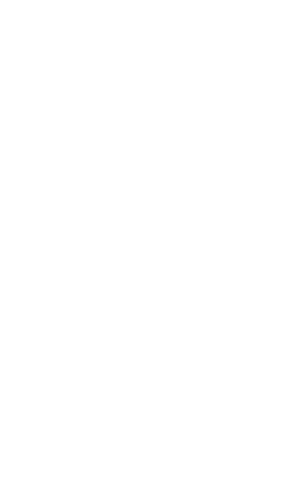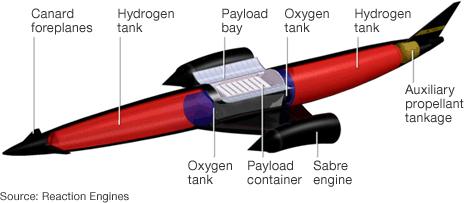Skylon: Ending 40 years of hurt
- Published
- comments

The robotic Skylon aims to put about 15 tonnes in low-Earth orbit
It is the 40th anniversary this October of the final Black Arrow flight from the Woomera range in Australia and the UK's abandonment of its satellite launch capability.
Britain remains the only nation to have given up the expertise of putting a payload in orbit on an indigenous rocket. So, it is perhaps not surprising that the Skylon venture generates so much interest.
This concept - for those not familiar with it - is for a re-usable spaceplane that could put up to 15 tonnes into an orbit several hundred km above the Earth. The expectation is that it would have an ultra-low operating cost, achieved through routine operation.
Its disruptive technology is a novel air-breathing and rocket engine that would enable the ship to go to space in one leap. It would not need the "stages" of conventional launch systems. Even the US space shuttle discards propulsion elements as it climbs into the sky.
Those of you who follow this column are always keen to hear the latest news on the British spaceplane concept, and the most recent development strikes me as being a key moment in what will be a critical few months.
The UK Space Agency initiated a review of Skylon and as part of that assessment it asked propulsion engineering experts at the European Space Agency to run the rule over the spaceplane and, in particular, its breakthrough Sabre engine design.
Esa is renowned for having top technical people and the fact that its experts could identify no immediate showstoppers, external is enormously encouraging.
On one level, of course, this ought not to be a surprise. If you think about it, the spaceplane concept has had people working on it for nearly 30 years - if you include development on the original iteration, the Rolls Royce/BAe Hotol vehicle, external. Any clear technical weaknesses should have been exposed by now.
That's not to say everything is plain sailing from here. The unexpected can always emerge to thwart best intentions, and in the case of Skylon the roadblocks may not be technical; they could just as easily be economic and political.
Remember, the company behind Skylon - Reaction Engines Limited - envisages the project as a commercial enterprise, and unless the private investors are forthcoming, the vehicle will never fly - no matter how smart the technology.
Likewise, there will be many regulatory hurdles ahead as a vehicle that is part-rocket, part-aeroplane attempts to get the proper licensing and authority to operate. All that said, the Esa assessment is very important.
If the Paris-based agency's report had expressed major reservations about some aspects of the design, it would have been enormously damaging. It has also signposted clearly the way ahead. Dr Mark Ford, Esa's head of propulsion engineering, told me:
"We've not looked at everything; we've focussed on the engine and the [Skylon's] structure. But from what we've seen so far, we can't identify any showstoppers. It's certainly a very interesting approach and it's a very interesting technology, let me put it that way.
"It has certain advantages over other approaches which have been proposed. As I've said in the report, namely that you can test the engine on the ground; you don't need to do an air launch or anything expensive. And also, it appears to have a high thrust to weight ratio, which again is another positive. So, it's quite an innovative technology if it works."

Sabre employs an extremely smart precooler heat-exchanger system ahead of its compressor.
If it didn't, the gases entering the engine intake at high speed would simply be too hot. Esa has witnessed a lab demonstration of the "secret" tech, shall we say, that part-underpins this system and confirms that it works.
Starting next month, a larger demonstration will take place on an experimental rig in Oxfordshire.
Assuming this receives full marks, Skylon will then move into what is termed "Phase 3".
This will be funded by £220m of private money and will see further fascinating developments. One will be the production of a sub-scale version of Sabre for ground demonstration. It will confirm whether Sabre can deliver the performance it needs to get Skylon into orbit in one leap.
It will demonstrate the full engine cycle - its air-breathing and rocket modes and the transition between the two. Alan Bond, the managing director of Reaction Engines, told me:
"As you know, we are getting close to carrying out a definitive test on the heat-exchanger technology. When we've completed that we shall be moving on to what we call Phase 3 at the end of this year, and a part of that programme will be to carry out a demonstration of a fully autonomous engine.
"What it would look like is something not dissimilar to a normal jet engine, but around the outside will be a tangle of pipes you've never seen before. It will be completely new. What we're going to do is put a large heat exchanger in front of the engine and then use the exhaust of another jet engine to actually heat the air going into the demonstrator.
"We can't quite get it up to the equivalent of Mach 5; it will go up to the equivalent of about Mach 4 and a bit, but that will be enough to demonstrate the system. We might do the transition to rocket mode in a separate set of experiments to that. It's actually quite difficult at small scale to do it all in one set-up. So, we might actually split the engine in half and do the demonstration of the transition on a second rig. We're in the early days of planning all this."
This demonstrator should be running by the end of 2013, beginning of 2014.

The other development to watch for is a flight of a Nacelle Test Vehicle (NTV). The Sabre engine is housed in a box - a nacelle. You can see its distinctive shape on the tips of the wings in the artist impressions of Skylon.
This isn't just any old box; it's design is integral to the successful operation of the spaceplane, managing the airflow and helping to control the engine. To prove its worth, Reaction Engines plans to build a fifth-scale-model and fly it. Alan Bond again:
"The NTV has rocket engines that accelerate it to around about Mach 5 and then it has internal ramjet combustion systems which will simulate the operation of the air-breathing engine, but the rest of the nacelle is a functional model of the real nacelle. So, it has all the control systems, all of the internal flow ducting that the real nacelle would.
"It also tells us quite a lot about the shock interactions with the wing which we've modelled a lot but which we'd like to have a physical comparison to check against.
"One of the problems of flying higher and faster is how do you demonstrate that you've got the intake right? One way is to build extremely expensive and complex wind tunnels, or find something you can hang the intake on. In this case, the easiest thing is to build a flying vehicle bespoke and put the intakes on it. It's planned to launch the NTV from the ground; it would be quite exciting."